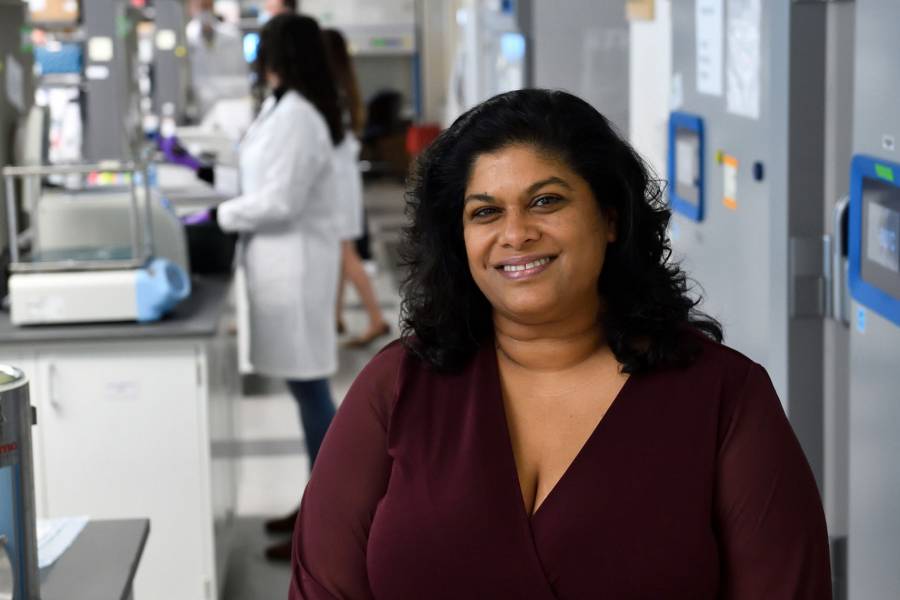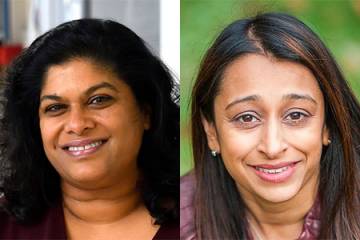As a new appointee to the White House's Cancer Advisory Board, Ashani Weeraratna will have a hand in setting the course for cancer research on a national level by embracing diversity—an approach that might become one of our best weapons in the fight against cancer.
Weeraratna, a Bloomberg Distinguished Professor of Cancer Biology, emphasizes the need to look at age, race, and sex to inform which cancer treatments are most effective for each patient. Her efforts have also been recognized by the National Cancer Institute, which recently named her one of five researchers who are "Accelerating Our Understanding of Cancer into the Future." Specifically, they cited Weeraranta for having "reshaped clinical practice with research findings on age-related differences in cancer treatment response" and for her commitment to helping develop a diverse and inclusive next generation of cancer researchers.
Weeraratna is the E.V. McCollum Professor and Chair in Biochemistry and Molecular Biology, and has an appointment in the Sidney Kimmel Comprehensive Cancer Center. She studies the molecular mechanisms involved in metastasis and how tumor microenvironments affect cancer progression and therapy resistance. Weeraratna has demonstrated that age-related changes in the microenvironment can contribute to multiple aspects of melanoma formation and development as well as therapy resistance.
In her upcoming book, Is Cancer Inevitable?, Weeraratna describes cancer's mechanisms and how teams like hers are finding ways to reduce its deadly impacts. It is an engaging account of the journey from her formative years in Sri Lanka and Lesotho to her education in the United States, and onward to appointments at elite governmental and academic institutions. The book, which will be released in December, is part of Johns Hopkins University Press' Johns Hopkins Wavelengths series, a collaboration with the Office of Research that aims to bring the work of Bloomberg Distinguished Professors to wider audiences.
How do age-related differences result in varied responses to cancer treatment?
One of the things we have found, for instance, is that as we age, the non-cancerous cells in your skin age as well, and they start to secrete different factors than the young their young counterparts, which can initiate changes within the tumor cell. So, for example, we found that older fibroblasts—cells that produce much of the structural framework for many tissues—secrete different types of lipids, or fats. This initiates a change in the tumor cells that makes them express a fatty acid transporter that takes those fats, brings them across the membrane to the inside of the cell, and then changes the metabolism of the tumor cells such that they no longer respond to therapy. What we learned from this study is that there is actually a specific receptor that we can target on those tumor cells in that population that can now make them more sensitive to therapy again.
What do these results mean for future cancer research and clinical practice?
I think the significance of our finding lies in showing that when we design and develop drugs in preclinical studies that are not appropriate to the age groups that we're actually treating in the clinic, we miss a huge chunk of information. What we're trying to do is fill in that knowledge gap. Especially when it comes to thinking about therapies, we tend to design all of our preclinical studies using mice that are six weeks old, which is like designing a study in 14-year-old humans, as opposed to looking at mice that are maybe 12 to 18 months old, which would more closely reflect the cancer patients population, because the incidence of most cancers increases dramatically after the age of 55. Really, this age group is where we should be modeling our studies. We need to make sure that we're designing clinical trials that encompass older people and that monitor their response differentially.
On the clinical side, we want to understand why patients don't respond to a treatment. When you're treating patients with melanoma with targeted therapy, for example, patients who are older do not have as good a response as patients who are younger. Scientifically, I've always found that fascinating because, especially in melanoma, we're treating a targeted mutation in a single gene with a single drug. One might expect that, if a drug that targets a particular mutation shuts off the signaling pathway, this should work and nothing else should matter. But in fact, the microenvironment—the cells, molecules, and structures such as blood vessels that surround the tumor—is critically important and speaks to what happens within the tumor cell. Finding age-related differences in treatment response also means that we can potentially design drugs that will specifically target older populations to enhance response. For instance, immunotherapy might have better outcomes in older patients than targeted therapy does. Conducting more future research with older cancer patients will hopefully help us find clinical approaches that are more effective.
Why do you think it's taken until now to find that there is an age-related difference in response to treatment?
I think that the aging field and then the cancer field, until recently, were very separate. Research around aging thinks about longevity, and how you increase longevity. The cancer field is, of course, focused on cancer. I personally had a very unique experience where I went from a cancer-based setting to the National Institute on Aging for a while, which allowed me to think about aging as a disease in and of itself, and then take those observations and apply them to our cancer work. I'm a big believer in microenvironment; when you're in one environment, it can really shape the way you think and behave compared to another environment. I was lucky to be able to transfer between a cancer research environment and an aging research environment and kind of join many of these observations together. This interdisciplinary background put me into a unique position to do this kind of research, especially when it came to thinking about what happens during aging, and asking questions such as "What are the changes that are going on during aging?" or "How can these changes influence cancer progression?"
Having accelerated our understanding of cancer into the future, where do you hope to take your research next?
In the immediate future, we have some specific targets that we have identified that can really enhance response to therapy. Specifically, there are molecules that are expressed either in microenvironmental cells or on the surface of tumor cells that we can target in order to kill the tumor cells without affecting too many of the non-cancerous cells. Now, I want to develop these into drugs for clinical trials to see if we can extend the lifespan of our cancer patients. Thinking globally, in the long term, I hope to change the way we approach the studies that we do. Our studies have been, in a way, single-minded. Of course, we have achieved great things in the cancer spectrum—if you have cancer now, you're likely going to live a lot longer than you would have 20 years ago. But despite that, we need to start to understand the nuances. What does it mean to be older? What does it mean to be a woman versus a man? What does it mean to be a person of color? How does your race play into your response to drugs? These are all crucial next steps for us to understand parameters beyond aging, such as sex and race as well.
What are the moments that you find the most exciting in your research?
A lot of the work done in my lab is done by trainees, who are really the ones who spearhead a lot of research and make incredible discoveries. They are the critical engine that drives the science. The most exciting moments are easy to identify: It's when a student runs into my office with a new result and says, "look at this!" To this day, a seemingly simple band on a gel makes me incredibly excited. These are the moments we live for. What excites me about this research is that it really is a new area. And, in a way, it brings in my interest in promoting diversity in science and understanding what it means to take a diverse approach to the science itself, because what our studies show is that understanding what is different between patients helps us to better treat them. And I think that this is so important.
You are a passionate advocate for junior faculty, women, immigrants, and people of color in science. Why do you see your advocacy work as such an important part of your role as a researcher, and what do you hope to achieve?
I grew up in southern Africa during the time of apartheid. I got to see firsthand what it meant to be excluded from spaces you weren't supposed to be in, physically, such as at a restaurant, but also intellectually: having many individuals not be able to contribute to a conversation made that conversation less rounded and less full. And I see that in science. We see women and underrepresented minorities have quieter voices than they should have in science because of the way the systemic structure has been for a really long time. It's important to me, as someone who went through a lot of difficulties as a woman of color in science, to make sure that the next generation doesn't go through that. I know how much value the voices of others have, and I want science to be a space where we can bring in and hear all of those thoughts and conversations. Without a diverse viewpoint, we're never going to cure cancer. And that's my ultimate goal.
I also hope to inspire generations of women to persist when sometimes it feels like they just want to give up and walk away. I want to make sure that, by the time I hang up my lab coat for the last time, we are thinking about race and gender and age in our clinical trials and designing our drugs to benefit all populations, not just one population. And I hope that through outreach work, we can start to dismantle the distrust of populations of color in hospitals and really get people into these clinical trials and get them treated, getting the help they need.
Posted in Health, Voices+Opinion
Tagged cancer, ashani weeraratna, bloomberg distinguished professors









